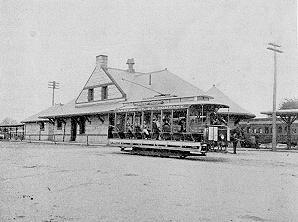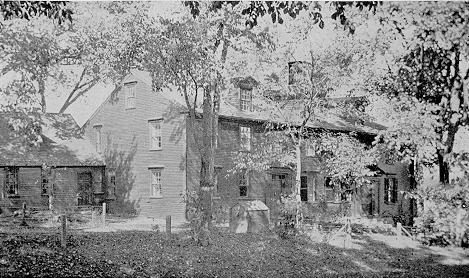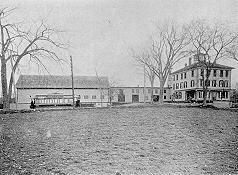By D. Fisher — 1900
Back to previous section — Forward to next section — Return to Table of Contents
CHAPTER 4
Places of Interest in Exeter
The visitor, having taken the car at the railroad station that runs south down Lincoln street and then through Garfield street, will see Arbor street on the right hand side, just as the car turns down Front street. Looking down Arbor street, a distant view is obtained of the great, rough granite boulder, surmounted by a life-size, bronze figure of a soldier on guard, which together form the unique monument of that talented lawyer and grim soldier, the late Gen. Gilman Marston. He had requested that a rough block of granite bearing only his name should be his monument. The huge block in question was selected by soldiers who had served under him in the battles of the Civil War.
Still further along, and on the right, in the point where Linden street joins Front, is an old house dating back to 1730, known as the Hildreth house. The Rev. George Whitefield was the guest of the owner, Col. Daniel Gilman, during Whitefield’s last visit to Exeter. But a few rods distant, and still on the right hand side of the street, will be seen a large oblong block of granite between the car track and sidewalk. On the side next the sidewalk is this inscription:
Here Preached
His Last Sermon,
Sept. 29, 1770.”
This sermon was preached in the open air because the church was not large enough to hold the people. The granite block marks the site where he stood. In the afternoon Whitefield rode to Newburyport, where he died the next morning. Just beyond, on the left, may be seen the new Phillips church, and then, on the same side, come the Phillips Exeter Academy buildings and their well-kept grounds.
Adjoining the academy grounds, on the same side, is the beautiful new public library and reading-rooms, built of cream-colored brick. It was erected by the town as a memorial building to Exeter’s soldiers. Polished stone tablets in the vestibule contain the names of the men thus honored. Exeter is justly proud of this memorial building with its free reading-rooms open to the public every day except Sundays, and of the large library in it.
Opposite the brick (Baptist) church, on the right hand side of the street, is the well-known gambrel-roofed Gilman house. It has been a noted place for more than one hundred and fifty years.
At the Squamscot House the car turns to the left down Court square. Opposite the hotel is a large church of the best colonial style. It bears a tablet which reads:
Founded in 1638.
Reorganized in 1698.
The House Built In 1798.”
Around it are smoothed and leveled grounds, which once were the site of one of the old cemeteries. “Early in the present century, on the sole authority of a few of the leading men of the town, all of the tombs and headstones were removed from the yard or leveled to the ground and covered with earth ……… On what grounds this act of vandalism was justified we cannot imagine.”
Building
Just beyond the church may be seen, first, the new courthouse, and second, the town hall. Opposite these buildings, stand some fine old residences, and the Register and Probate Court building.
The brick building on the right, as the car turns into Water street, now used for offices, is known as the Tilton, or later Dearborn, house. It dates from 1770 and was built by Col. Samuel Folsom, who used it as a public inn. It is locally notable because President Washington on his return from Portsmouth to Boston, by the way of Exeter and Haverhill, was entertained here by Col. Nicholas Gilman, a member of his staff at Yorktown, and other citizens of Exeter.
Just as the road turns to cross the river bridge, on the right is a brown house with a wing at the rear. The wing, extending toward the side street, was built of squared logs and is held to be the oldest inhabited building in Exeter. It is known as the Clifford house, and was erected by Chancellor John Gilman, who was living in it in 1676. It is believed to date back to 1658. While a pupil at the Phillips academy in 1796, Daniel Webster boarded in this house.
Going west from the town hall along Water street, the second building from the town hall on the left, now known as the EXETER INN, was erected in 1725, and used as an inn by Samuel Gilman. After many changes in ownereship it was moved nearer the street and forms the upper and hotel portion of the block of which it is a part. Still further west on a rise of ground, somewhat off the street, also on the left hand side, is an old residence known as the Ladd house. It dates from 1721.
Just beyond the Ladd house the car ascends Town hill and runs through Main street toward the railroad station. From Town hill, the first street on the right is Cass street. But a few rods from Main street, on the right hand corner of Cass and Green streets, is a large white house in spacious grounds. It is known as the Cass house, and was the birthplace of Gen. Lewis Cass of early Western fame.
Beyond the Cass house, and just where Cass street joins Summer and Park streets, is a large, gambrel-roofed house of the best colonial style of architecture. It was built in 1737 by Major John Gilman, of French and Indian War fame. It is now known as the Odiorne house. On the corner of Park and Summer streets, across Winter street from the Odiorne house, is a large square house fronting on Winter and Summer streets. It was built in 1724 and is now known as the Rowland house. It was once a noted inn. In 1734 the men engaged in the Mast Tree riot met here to assume their Indian disguises.




